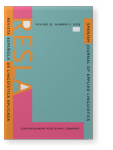Vol. 32:2 (2019) ► pp.573–589
Vol. 32:2 (2019) ► pp.573–589
On the cognitive grounding of agent-deprofiling constructions as a case of pretense constructions
Agent-deprofiling constructions have the function of drawing the language user’s attention to the non-agentive elements of a predication, while endowing one of these elements with agent-like qualities. Members of this family are the inchoative, middle, instrument-subject, location-subject, and cause-subject constructions. These constructions have been discussed in the literature, especially in projectionist accounts of language, without adequately accounting for their relatedness, which in our view can best be done by investigating their grounding in cognition. The present article addresses this issue by considering agent-deprofiling constructions as belonging to the class of what we term pretense constructions. Pretense constructions provide non-descriptive, or re-construed, representations of states, situations, or events. Because of their re-construed nature, which involves metaphor and/or metonymy, in these configurations there is no one-to-one match between the semantic and syntactic functions of their elements. We discuss how this reorganization of the semantic and syntactic function of constructional elements produces specific meaning implications that can be motivated by underlying metaphoric and metonymic shifts, sometimes working in cooperation.
Article outline
- 1.Introduction
- 2.What is not a pretense construction
- 3.The inchoative and middle constructions
- 4.The instrument-subject construction
- 5.Conclusion
- Acknowledgements
-
References
